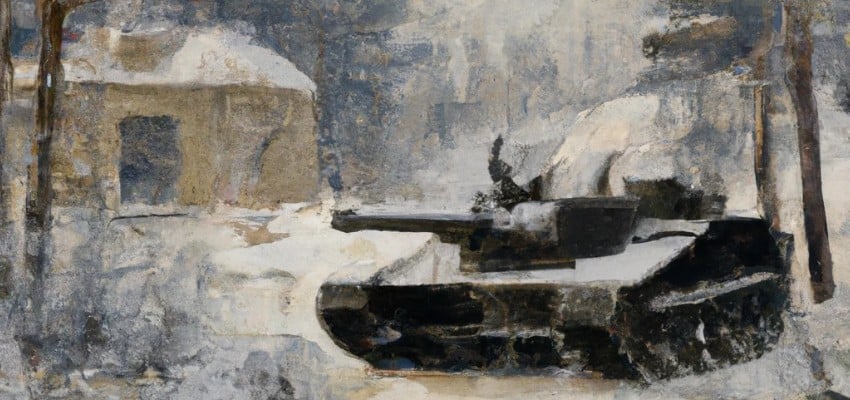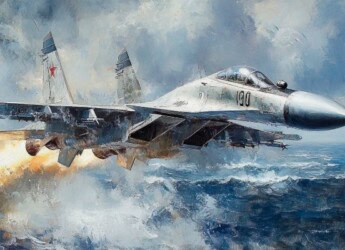|
|
Content Assessment: Windows of Opportunity? Ukraine Conflict Assessments in Maps (November 28-December 4, 2022)
Information - 94%
Insight - 95%
Relevance - 93%
Objectivity - 92%
Authority - 93%
93%
Excellent
A short percentage-based assessment of the qualitative benefit of the post highlighting the recent Ukraine conflict assessments in maps from the Institute for the Study of War.
Editor’s Note: One of the most accurate and detailed sources for ongoing updates on the Ukraine crisis is the Ukraine Conflict Update from the Institute for the Study of War. The Institute for the Study of War (ISW) is a 501(c)(3) organization and produces strictly non-partisan, non-ideological, fact-based research. ISW seeks to promote an informed understanding of war and military affairs through comprehensive, independent, and accessible open-source research and analysis. ISW’s research is made available to the general public, military practitioners, policymakers, and media members. Providing a daily synthesis of key events related to the Russian aggression against Ukraine, ISW updates may benefit cybersecurity, information governance, and legal discovery professionals as they follow the business, information technology, and legal trends and trajectories impacted by and stemming from the current Ukraine conflict.
Assessment and Maps*
Ukraine Conflict Assessments – An Overview in Maps
- Institute for the Study of War (ISW), Russia Team
- Critical Threats Project (CTP), American Enterprise Institute
General Assessment Background Info
- ISW systematically publishes Russian campaign assessments that include maps highlighting the assessed control of terrain in Ukraine and main Russian maneuver axes.
- These maps augment daily synthetic products that cover key events related to renewed Russian aggression against Ukraine.
The Russian Offensive Campaign Assessments
- December 4, 2022
- By George Barros, Grace Mappes, Riley Bailey, Karolina Hird, Layne Philipson, Angela Howard, and Frederick W. Kagan
Key Development
- Ukrainian officials have indicated that Ukrainian forces plan to continue offensive operations over the coming winter to capitalize on recent battlefield successes and prevent Russian forces from regaining the battlefield initiative. However, senior US government officials are mistakenly identifying the optimal window of opportunity for Ukraine to conduct more counteroffensives as spring rather than winter, despite Ukrainian officials’ statements to the contrary.
Key Takeaways
- Ukrainian officials have indicated that Ukrainian forces will continue counteroffensive operations over the upcoming winter.
- Ukraine’s ability to maintain the military initiative depends on Ukrainian forces continuing counteroffensive operations in the winter of 2022-2023.
- Russian sources reported that Ukrainian forces continued counteroffensive operations in the directions of Kreminna and Svatove.
- Russian forces continued to conduct offensive operations around Bakhmut and Avdiivka.
- Groups of mobilized Russian soldiers continue to disrupt Russian force generation efforts with refusals to fight, insubordination, and defiance.
- Russian forces likely publicly executed residents in occupied Luhansk Oblast on accusations of partisan activity.
- December 3, 2022
- By Riley Bailey, George Barros, Karolina Hird, Nicholas Carl, and Frederick W. Kagan
Key Development
- French President Emmanuel Macron amplified Russian information operations about the West’s need to discuss Russian “security guarantees” in a televised interview on December 3.
Key Takeaways
- Ukrainian forces reportedly reached the east (left) bank of the Dnipro River across from Kherson City.
- French President Emmanuel Macron amplified Russian information operations about the need for NATO to consider “security guarantees” to be given to Russia during putative negotiations in a televised interview on December 3.
- Conditions in eastern Ukraine are likely becoming more conducive to a higher pace of operations as winter sets in.
- The Russian and Belarusian Ministers of Defense met in Minsk likely to further strengthen bilateral security ties between Russia and Belarus.
- Ukrainian forces likely continue to advance northwest of Kreminna.
- Russian forces continued ground attacks around Bakhmut, in the Avdiivka-Donetsk City area, and in western Donetsk and eastern Zaporizhia oblasts.
- Russian authorities reportedly evacuated Russian collaborators from Oleshky.
- The Russian National Guard’s (Rosgvardia) Organizational and Staff Department confirmed that mobilization continues despite Russian President Vladimir Putin’s announcement of the formal end of partial mobilization on October 31.
- Russian authorities are continuing to use judicial measures to consolidate administrative control of occupied territories.
- December 2, 2022
- By Riley Bailey, Kateryna Stepanenko, Grace Mappes, Yekaterina Klepanchuk, and Frederick W. Kagan
Key Development
- Russia is attempting to capitalize on the Western desire for negotiations to create a dynamic in which Western officials feel pressed to make preemptive concessions to lure Russia to the negotiating table.
Key Takeaways
- Russia is attempting to capitalize on the Western desire for negotiations to create a dynamic in which Western officials feel obliged to make preemptive concessions to lure Russia to the table.
- Russian Foreign Minister Sergei Lavrov reiterated as the basis for negotiations precisely the same demands that the Russian Foreign Ministry had made before the February 24 invasion, and Kremlin Spokesperson Dmitrii Peskov added the further demand that the West recognize Russia’s annexation of Ukrainian territory.
- Russian forces still pose a threat to Ukrainian energy infrastructure despite the success of Ukrainian air defenses.
- Additional Western air defense systems are prompting the Russian pro-war community to question the Russian air campaign against Ukrainian infrastructure.
- Russian officials are setting conditions to negotiate the demilitarization of the Zaporizhzhia Nuclear Power Plant (ZNPP), an agreement upon which Russia would likely renege and that would not eliminate or diminish the ongoing threat to the ZNPP.
- Ukrainian forces made localized breakthroughs southwest and northwest of Kreminna.
- Russian forces continued to make minimal advances in the Bakhmut area and conduct offensive operations in the Avdiivka–Donetsk City area.
- Russian forces may be struggling to properly allocate and deploy forces in rear areas in southern Ukraine due to Ukrainian strikes.
- Poor logistics, unruly mobilized personnel, and domestic protests continue to prevent the Kremlin from achieving the goals of partial mobilization.
- Russian President Vladimir Putin continues to attempt to mask military development projects in occupied territories for no obvious reason.
- December 1, 2022
- By Riley Bailey, Madison Williams, Yekaterina Klepanchuk, Kateryna Stepanenko, and Frederick W. Kagan
Key Development
- Belarusian President Alexander Lukashenko continued to set informational conditions to resist Russian pressure to enter the war against Ukraine by claiming that NATO is preparing to attack Belarus.
Key Takeaways
- Belarusian President Alexander Lukashenko continued to set informational conditions to resist Russian pressure to enter the war against Ukraine.
- Russian forces continued efforts to defend against Ukrainian counteroffensive operations along the Svatove-Kreminna line.
- Russian forces continued to make incremental gains around Bakhmut and to conduct offensive operations in the Avdiivka-Donetsk City area.
- Russian forces continued to conduct defensive measures and move personnel on the east bank of the Dnipro River in Kherson Oblast.
- Russian military movements in Zaporizhia Oblast may suggest that Russian forces cannot defend critical areas amidst increasing Ukrainian strikes.
- Russian forces are holding reserves in Crimea to support defensive operations in Zaporizhia Oblast and on the east bank of the Dnipro River.
- The Kremlin’s financial strain continues to feed domestic unrest.
- Evidence persists regarding the continuation of partial mobilization in the face of low morale and high desertion rates amongst Russian troops.
- Wagner Group financier Yevgeniy Prigozhin continued attempts to bolster the Wagner Group’s reputation.
- Russian occupation officials continued efforts to integrate occupied territories into the Russian financial and legal spheres.
- Russian forces continued to exploit Ukrainian civilians and civilian infrastructure in support of Russia’s war effort in Ukraine.
- November 30, 2022
- By Karolina Hird, Riley Bailey, Madison Williams, Yekaterina Klepanchuk, and Frederick W. Kagan
Key Development
- Russian efforts around Bakhmut indicate that Russian forces have fundamentally failed to learn from previous high-casualty campaigns concentrated on objectives of limited operational or strategic significance.
Key Takeaways
- The Russian military’s efforts around Bakhmut suggest that Russian forces failed to learn from previous costly campaigns focused on operationally insignificant settlements.
- Russian state nuclear company Rosenergoatom appointed a new director for the Zaporizhzhia Nuclear Power Plant.
- The Kremlin continues efforts to stifle domestic dissent through an expansion of measures ostensibly aimed against “foreign agents.”
- Russian opinion polling suggests that the Russian public may be growing tired of Russia’s war in Ukraine.
- Russian forces continued efforts to defend against Ukrainian counteroffensive operations along the Svatove-Kreminna line.
- Russia forces continued to make incremental gains around Bakhmut and to conduct offensive operations in the Avdiivka-Donetsk City area.
- A Ukrainian official acknowledged that Ukrainian forces are conducting an operation on the Kinburn Spit.
- Russian and Ukrainian sources indicated that Russian officials are continuing to conduct partial mobilization measures.
- Russian officials’ ongoing efforts to integrate illegally annexed territories into the Russian Federation are likely very disorganized.
- November 29, 2022
- By Grace Mappes, Madison Williams, Yekaterina Klepanchuk, Angela Howard, Karolina Hird, and Frederick W. Kagan
Key Development
- The United Kingdom Ministry of Defense (MoD) reported on November 29 that Russian forces have likely stopped deploying battalion tactical groups (BTGs) in the past three months.
Key Takeaways
- Russian forces made marginal gains around Bakhmut on November 29, but Russian forces remain unlikely to have advanced at the tempo that Russian sources claimed.
- The United Kingdom Ministry of Defense (MoD) reported that Russian forces have likely stopped deploying battalion tactical groups (BTGs) in the past three months, supporting ISW’s prior assessments.
- Russian forces continued to defend against Ukrainian counteroffensive operations around Svatove as Ukrainian forces continued counteroffensive operations around Svatove and Kreminna.
- Russian forces continued limited ground attacks west of Kreminna to regain lost positions.
- Russian forces conducted ground attacks near Siversk and Avdiivka, and in western Donetsk Oblast.
- Russian forces continued strengthening defensive positions in eastern Kherson Oblast as Ukrainian forces continued striking Russian force concentrations in southern Ukraine.
- Russian forces continued to struggle with outdated equipment and domestic personnel shortages amid official actions indicative of a probable second wave of mobilization.
- An independent investigation found that Russia may have transported thousands of Ukrainian prisoners from penal colonies in occupied Ukraine to Russia following the withdrawal from the west bank of Kherson Oblast.
- November 28, 2022
- By Karolina Hird, George Barros, Grace Mappes, Layne Philipson, Madison Williams, and Frederick W. Kagan
Key Development
- Russian forces are likely preparing to launch a new wave of missile strikes across Ukraine in the coming week, but such preparations are likely intended to sustain the recent pace of strikes instead of escalating it due to continued constraints on Russia’s missile arsenal.
Key Takeaways
- The Russian-claimed capture of several small villages around Bakhmut on November 27 and 28 does not portend an imminent Russian encirclement of Bakhmut.
- Recent Russian force deployments to Belarus in November 2022 are likely part of a Russian effort to augment Russian training capacity and conduct an information operation.
- Russian milbloggers widely criticized the Russian Ministry of Defense’s (MoD) decision to place severe customs limits on the import of dual-use goods, indicating a continued and pervasive discontent with the Russian MoD’s conduct of the war in Ukraine.
- Russian forces are likely preparing to launch a new wave of missile strikes across Ukraine in the coming week, but such preparations are likely intended to sustain the recent pace of strikes rather than increase it.
- Russian forces continued efforts to defend against Ukrainian counteroffensive operations around Svatove as Russian sources reported that Ukrainian troops continued counteroffensive west of Kreminna.
- Russian forces made incremental gains south of Bakhmut.
- Russian forces continued to strengthen fortified positions and establish security measures in eastern Kherson Oblast.
- Ukrainian forces continued to strike Russian military assets and along critical logistics lines in southern Ukraine.
- Russian forces continue to face issues with adequate training and equipment and challenges with morale and discipline as Russian military failures have significant domestic social impacts.
- Russian occupation authorities continued efforts to facilitate the integration of educational systems in occupied Ukraine into the Russian system.
We do not report in detail on Russian war crimes because those activities are well-covered in Western media and do not directly affect the military operations we are assessing and forecasting. We will continue to evaluate and report on the effects of these criminal activities on the Ukrainian military and population and specifically on combat in Ukrainian urban areas. We utterly condemn these Russian violations of the laws of armed conflict, Geneva Conventions, and humanity even though we do not describe them in these reports.
Chronology of Maps from November 28 – December 4, 2022 – Mouseover to Scroll
Ukraine Conflict Maps - 112822 - 120422See the Institute for the Study of War Interactive Map of the Russian Invasion
Read the latest Ukraine Conflict updates from the Institute for the Study of War
* Shared with direct express permission from the Institute for the Study of War (ISW).
About the Institute for the Study of War Research Methodology
ISW’s research methodology relies on both primary and secondary sources, enabling researchers to develop a comprehensive understanding of the situation on the ground. In order to analyze military and political developments in any given area, ISW’s research analysts must wholly understand the systems of enemy and friendly forces. They must also understand the population demographics, physical terrain, politics, and history of that area. This lays the analytical foundation for understanding the reasons for particular developments and fulfilling their assigned research objectives. ISW analysts also spend time in places like Iraq, Afghanistan, and elsewhere in order to gain a better understanding of the security and political situation and to evaluate the implementation of current strategies and policies. Our researchers compile data and analyze trends, producing a granular analysis of developments in areas of research, producing an accurate, high-resolution, timely, and thorough picture of the situation. ISW’s research methodology guarantees its success and commitment to improving the nation’s ability to execute military operations, achieve strategic objectives, and respond to emerging problems that may require the use of American military power.
About the Institute for the Study of War
The Institute for the Study of War advances an informed understanding of military affairs through reliable research, trusted analysis, and innovative education. We are committed to improving the nation’s ability to execute military operations and respond to emerging threats in order to achieve U.S. strategic objectives. ISW is a non-partisan, non-profit, public policy research organization.
Learn more, get involved, and contribute today.
Additional Reading
- [Annual Update] International Cyber Law in Practice: Interactive Toolkit
- Data Embassies: Sovereignty, Security, and Continuity for Nation-States
Source: ComplexDiscovery



























